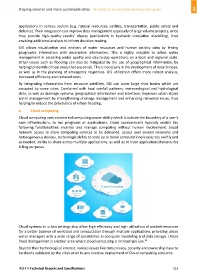Page 529 - Shaping smarter and more sustainable cities - Striving for sustainable development goals
P. 529
applications in various sectors (e.g. natural resources, utilities, transportation, public safety and
defence). Their integration can improve data management especially of large volume projects, since
they provide high quality results' display (particularly in hydraulic simulation modelling), thus
enabling additional analysis to inform decision‐making.
GIS allows visualization and analysis of water resources and human activity data by linking
geographic information with descriptive information. This is highly valuable to urban water
management in assessing water quality and day‐to‐day operations on a local and regional scale.
Other issues such as flooding can also be mitigated by the use of geographical information, by
helping to identify critical areas that are at risk. This is necessary in the development of hazard maps,
as well as in the planning of emergency responses. GIS utilization offers more robust analysis,
increased efficiency and reduced costs.
By integrating information from resource satellites, GIS can cover large river basins which are
occupied by some cities. Combined with local rainfall patterns, meteorological and hydrological
data, as well as drainage systems, geographical information and interfaces improves urban storm
water management by strengthening drainage management and enhancing rainwater reuse, thus
helping to reduce the prevalence of urban flooding.
e. Cloud computing
Cloud computing uses an external computing power ability which is outside the boundary of a user's
own infrastructure, to run programs or applications. Cloud environments typically enable the
following functionalities: monitor and manage computing without human involvement, broad
network access to allow computing services to be delivered, access over several networks and
heterogeneous devices, technologic ability to scale up or down computational resources swiftly and
as needed, ability to share across multiple applications, as well as to track applications/tenants for
billing purposes.
Cloud systems in urban settings also allow high efficiency and high utilization of pooled resources
for a better balance of workload and computation through multiple applications, providing urban
water managers with a wide range of possibilities in computer modelling and data storage. Urban
28
flood management is another area where cloud computing is increasingly use.
Beyond their technological interest, various issues like data privacy, security and ownership have to
be clearly validated by the cities prior to any massive deployment of Cloud computing solutions.
ITU‐T's Technical Reports and Specifications 519

